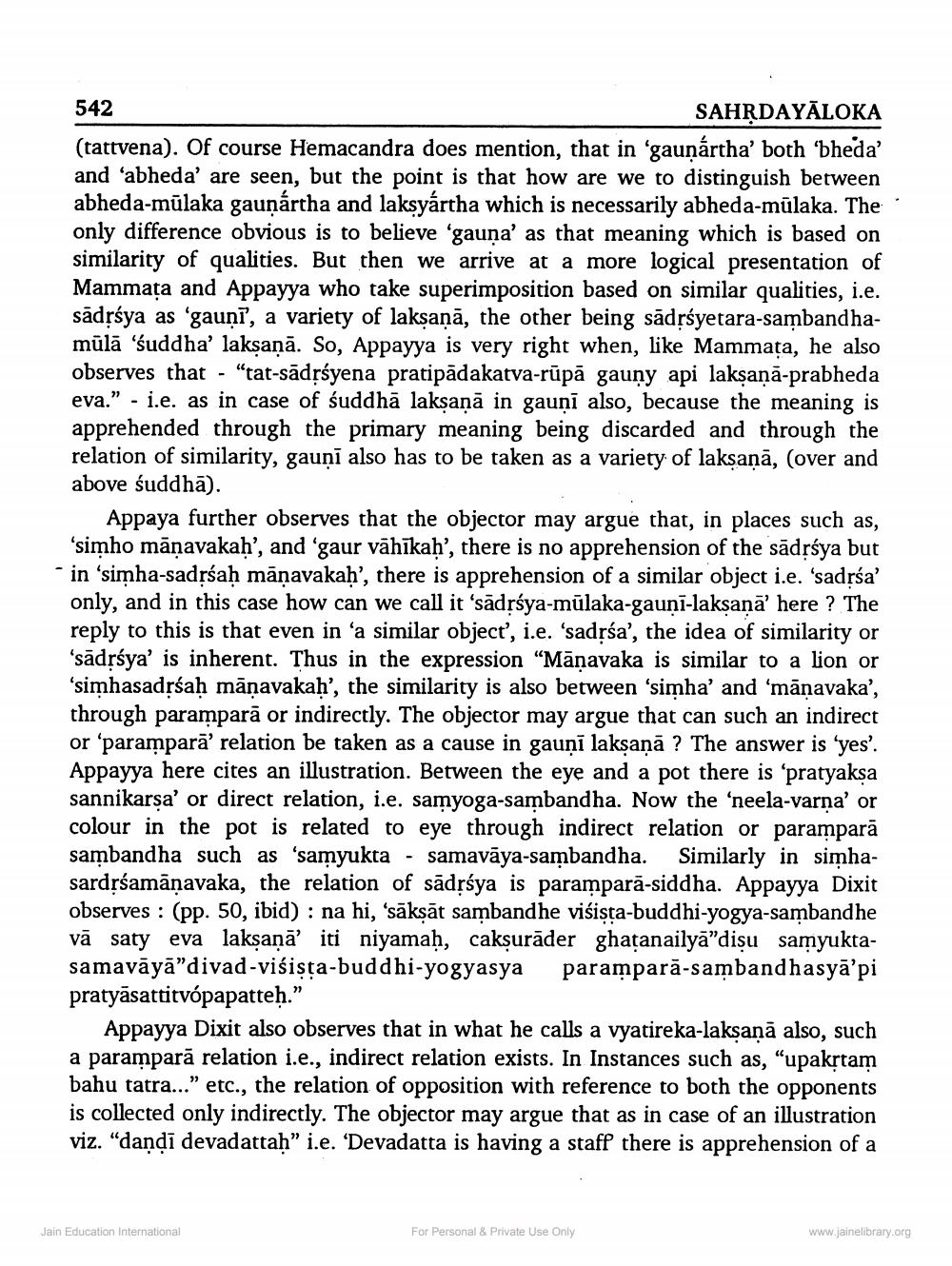________________
542
SAHRDAYĀLOKA (tattvena). Of course Hemacandra does mention, that in 'gauņártha’ both 'bheda’ and ‘abheda' are seen, but the point is that how are we to distinguish between abheda-mülaka gaunártha and laksyártha which is necessarily abheda-mül only difference obvious is to believe 'gauna' as that meaning which is based on similarity of qualities. But then we arrive at a more logical presentation of Mammața and Appayya who take superimposition based on similar qualities, i.e. sāděśya as 'gauņi, a variety of laksaņā, the other being sādrśyetara-sambandhamülā 'śuddha' laksanā. So, Appayya is very right when, like Mammata, he also observes that - "tat-sādịśyena pratipādakatva-rūpā gauny api lakṣaṇā-prabheda eva." - i.e. as in case of suddhā laksana in gauni also, because the meaning is apprehended through the primary meaning being discarded and through the relation of similarity, gauni also has to be taken as a variety of laksanā, (over and above suddhā).
Appaya further observes that the objector may argue that, in places such as, 'simho māņavakah', and 'gaur vāhīkaḥ', there is no apprehension of the sādrśya but - in ‘simha-sadrśaḥ māņavakah', there is apprehension of a similar object i.e. 'sadrśa' only, and in this case how can we call it 'sādrśya-mülaka-gauni-laksanā' here? The reply to this is that even in 'a similar object, i.e. 'sadrśa', the idea of similarity or 'sādřśya' is inherent. Thus in the expression “Mānavaka is similar to a lion or 'simhasaděśaḥ māņavakah', the similarity is also between 'simha' and 'māņavaka', through paramparā or indirectly. The objector may argue that can such an indirect or 'paramparā' relation be taken as a cause in gauni laksaņā ? The answer is 'yes'. Appayya here cites an illustration. Between the eye and a pot there is ‘pratyaksa sannikarsa' or direct relation, i.e. samyoga-sambandha. Now the 'neela-varna' or colour in the pot is related to eye through indirect relation or paramparā sambandha such as 'samyukta - samavāya-sambandha. Similarly in simhasardịśamāṇavaka, the relation of sādņśya is paramparā-siddha. Appayya Dixit observes : (pp. 50, ibid): na hi, 'sākṣāt samband he viśista-buddhi-yogya-samband he vā saty eva laksanā'itiniyamah, cakşurăder ghatanailyā"dişu samyuktasamavāyā"divad-viśista-buddhi-yogyasya paramparā-sambandhasya'pi pratyāsattitvopapatteh."
Appayya Dixit also observes that in what he calls a vyatireka-laksana also, such a paramparā relation i.e., indirect relation exists. In Instances such as, “upakstam bahu tatra..." etc., the relation of opposition with reference to both the opponents is collected only indirectly. The objector may argue that as in case of an illustration viz. "dandi devadattah” i.e. 'Devadatta is having a staff there is apprehension of a
Jain Education International
For Personal & Private Use Only
www.jainelibrary.org




